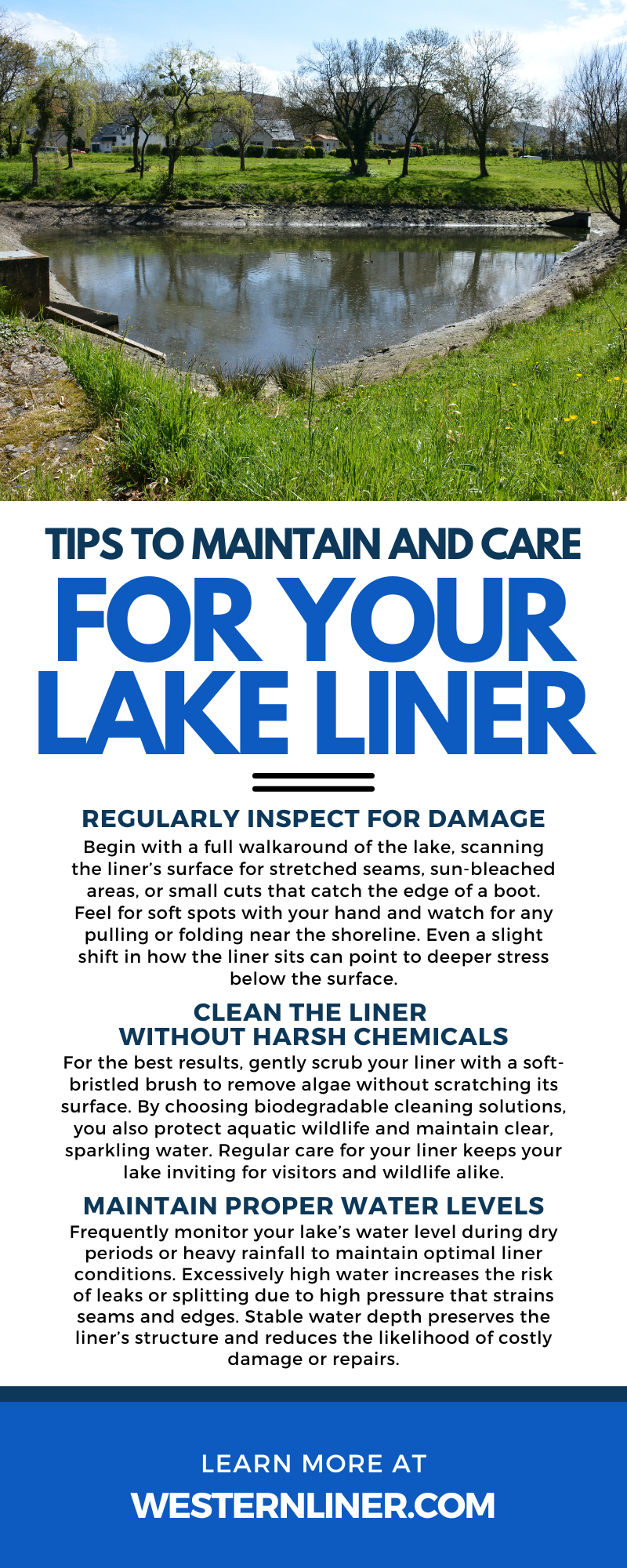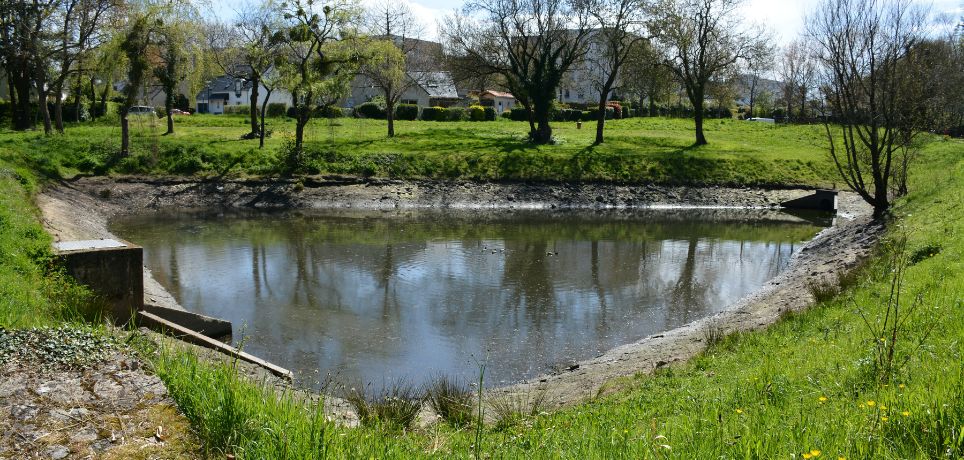Your lake liner provides a critical protective barrier, preventing leaks and preserving clean water on your property. Proper liner maintenance prolongs its lifespan, reduces unexpected repair costs, and keeps your lake visually appealing throughout every season. Simple, consistent care makes a significant difference in preserving liner integrity and water quality.
Regularly Inspect for Damage
Liner failure rarely starts with something obvious. More often, it begins with a faint discoloration, a weak seam, or a tiny tear that expands under pressure. Seasonal changes, heavy foot traffic, and exposure to sun all leave behind early signs that only appear if you know where to look.
Start each season by closely examining your lake liner for punctures, seam separations, and surface wear. Early identification of small tears prevents minor issues from escalating into major liner failures. One of the best tips to maintain and care for your lake liner is to conduct a proactive examination of potential liner issues.
Begin with a full walkaround of the lake, scanning the liner’s surface for stretched seams, sun-bleached areas, or small cuts that catch the edge of a boot. Feel for soft spots with your hand and watch for any pulling or folding near the shoreline. Even a slight shift in how the liner sits can point to deeper stress below the surface.
After storms or sudden drops in water level, return for a second inspection. Focus on corners and places where equipment rests or water flows more aggressively. Damage often spreads from points of repeated tension, so revisiting those weak spots helps you catch changes before they escalate.
You can also keep a simple log of recurring trouble spots. Record where issues appear, what the damage looks like, and how it changes over time. By tracking details, you turn quick checks into a pattern that reveals weaknesses before they fail completely.
Clean the Liner Without Harsh Chemicals
Routine liner cleaning keeps algae, dirt, and sediment from dulling the appearance of your lake. Instead of reaching for harsh products, you can opt for gentle, liner-specific cleaners that protect the surface from unnecessary damage. Harsh chemicals like bleach quickly strip away protective coatings and can leave your liner worn.
For the best results, gently scrub your liner with a soft-bristled brush to remove algae without scratching its surface. By choosing biodegradable cleaning solutions, you also protect aquatic wildlife and maintain clear, sparkling water. Regular care for your liner keeps your lake inviting for visitors and wildlife alike.
Additionally, after heavy storms or windy days, you can easily remove debris like leaves and branches from your liner using a soft broom or net. Quickly clear away natural debris to prevent staining and mold growth and to preserve your liner’s attractive appearance. Staying attentive to post-storm cleanup helps your liner look great all season.
You can also schedule periodic cleaning at set intervals to simplify the maintenance process. Liner care becomes routine rather than an overwhelming chore when you establish a regular cleaning schedule. A consistent schedule allows enjoyment of any beautiful lake without the stress of unexpected maintenance surprises.
Maintain Proper Water Levels
Consistent water levels significantly extend the life of your lake liner by reducing unnecessary stress and exposure. Sudden fluctuations increase tensions and the risk of tearing. However, you can work to install overflow drains or automatic refill systems to stabilize water depth and protect the liner from harmful UV exposure.
Frequently monitor your lake’s water level during dry periods or heavy rainfall to maintain optimal liner conditions. Excessively high water increases the risk of leaks or splitting due to high pressure that strains seams and edges. Stable water depth preserves the liner’s structure and reduces the likelihood of costly damage or repairs.
Prevent Vegetation and Root Intrusion
Vegetation growth near lake edges frequently leads to damaging root penetration beneath the liner surface. Install protective root barriers along the lake perimeter to prevent roots from puncturing or shifting the liner material. Regular trimming of nearby trees and shrubs reduces potential root damage and keeps your liner safe from invasive growth.
Select plant species known for shallow root systems to minimize risk near your lake’s edges. Aggressive root growth easily penetrates liner materials, causing subtle but harmful punctures over time. Preventative landscaping practices actively reduce root intrusion risk, saving your liner from hidden and expensive damages.
Protect the Liner From UV and Weather Exposure
Exposure to harsh sunlight and severe weather rapidly weakens lake liner materials, leading to cracks and brittleness. Installing UV-resistant covers or shade structures effectively limits direct sunlight and slows liner deterioration significantly. Another practical tip to maintain and care for your lake liner involves using protective measures against prolonged weather exposure.
During winter months, draining excess water below the liner’s upper edges prevents ice formation damage. Protective covering prevents prolonged direct sun exposure that weakens the liner’s durability over time. Simple weather-protection measures substantially increase your liner’s resilience against environmental damage year-round.
Choose the Right Liner Material From the Start
Selecting the appropriate liner material from the beginning significantly reduces future maintenance efforts and extends your liner’s lifespan. Options such as PVC, RPE, HDPE, or reinforced liners each offer unique benefits suited to different lake conditions and usage. Evaluate flexibility, durability, and puncture resistance carefully to choose the liner material that best matches your property’s needs.
Consider the environmental conditions your lake regularly faces, including temperature fluctuations and potential root intrusion from nearby plants. Flexible liners like RPE adapt well to temperature changes, while thicker HDPE liners resist punctures effectively.
Finding the right material is easier when relying on a trusted supplier. Businesses like Western Environmental Liner provide various high-quality lake liners for sale that are lighter and more durable compared to materials such as HDPE.
Ultimately, selecting the right liner material prevents unnecessary costs and frequent maintenance headaches in the long run. Think carefully about your lake’s purpose, environmental factors, and expected usage when you choose your liner type and thickness. A well-informed decision upfront contributes greatly to your lake’s overall longevity and keeps maintenance manageable year after year.
Keep Wildlife and Equipment From Damaging the Liner
Wildlife activity around lakes frequently results in accidental liner damage through scratching or punctures. You can install gentle wildlife deterrents or protective barriers that reduce direct contact between animals and the liner surface. Also consider fencing or subtle perimeter modifications to discourage wildlife from accessing vulnerable liner areas.
Heavy equipment, including docks or maintenance tools, easily damage liner surfaces without proper precautions. Placing protective mats beneath docks and walkways prevents punctures or abrasions caused by frequent contact. Design access points strategically to limit heavy machinery contact to preserve your liner’s integrity effectively.
Maintaining your lake liner with proactive measures safeguards its durability and preserves your property’s aesthetic appeal. For expert assistance or reliable liner options, contact Western Environmental Liner today.



